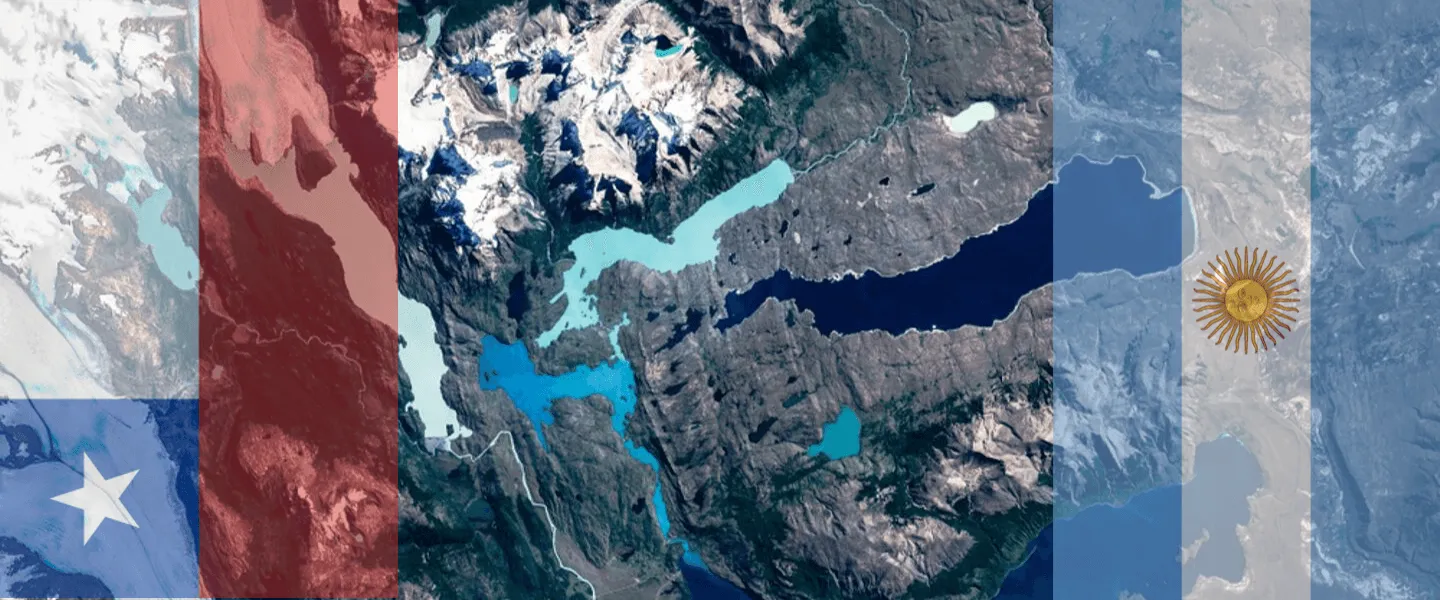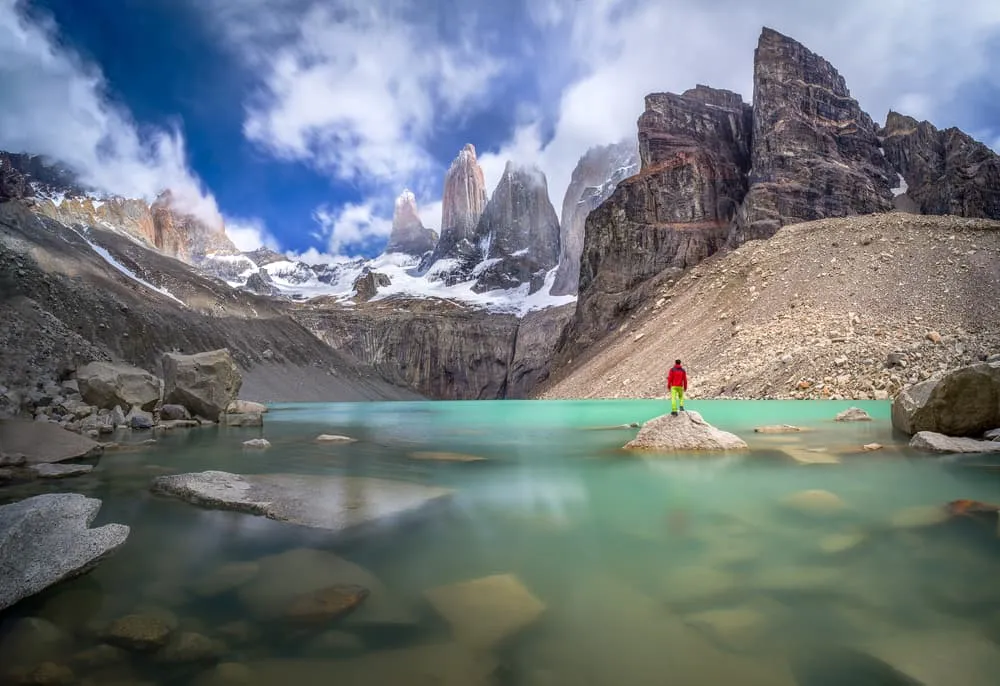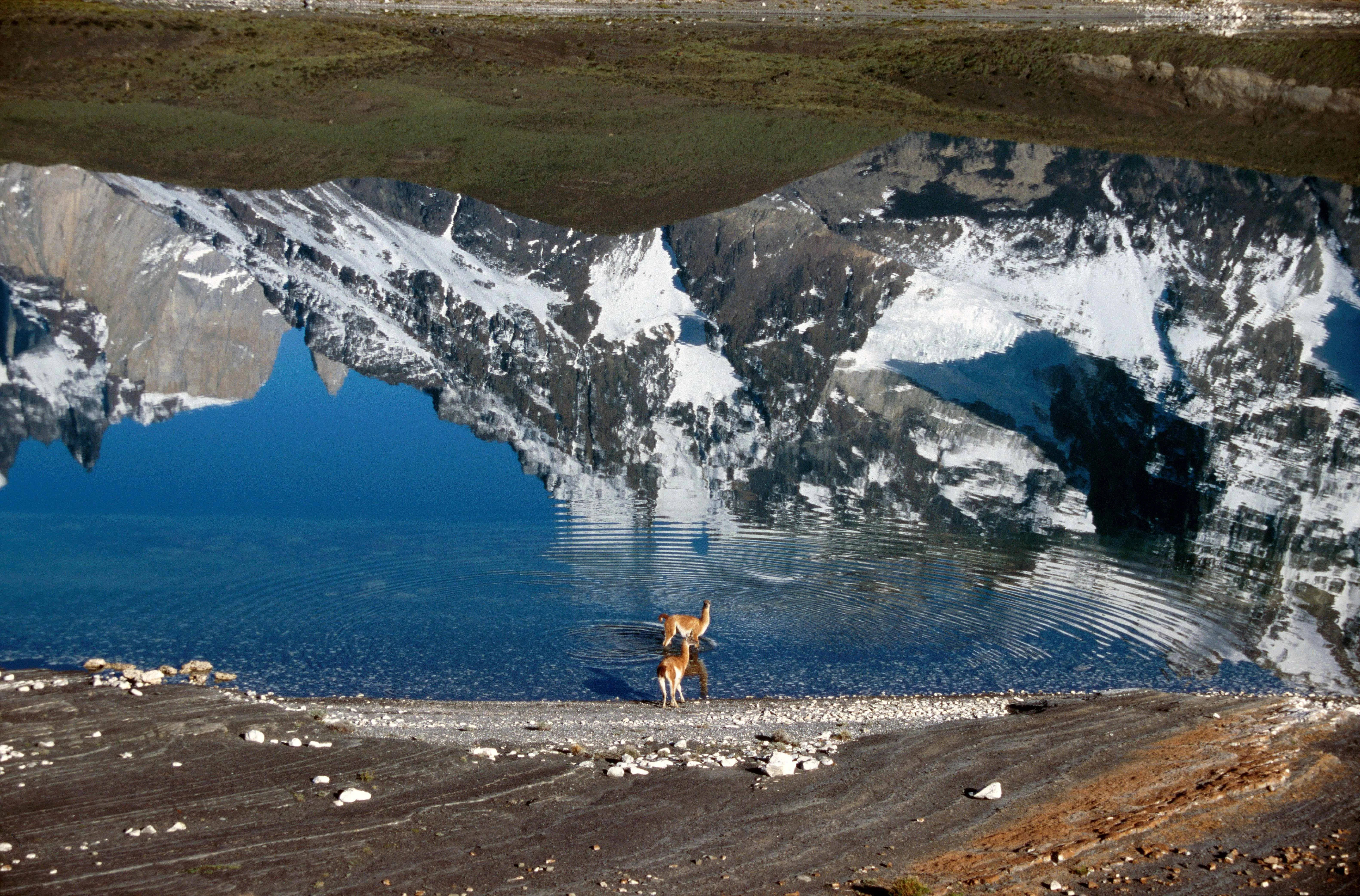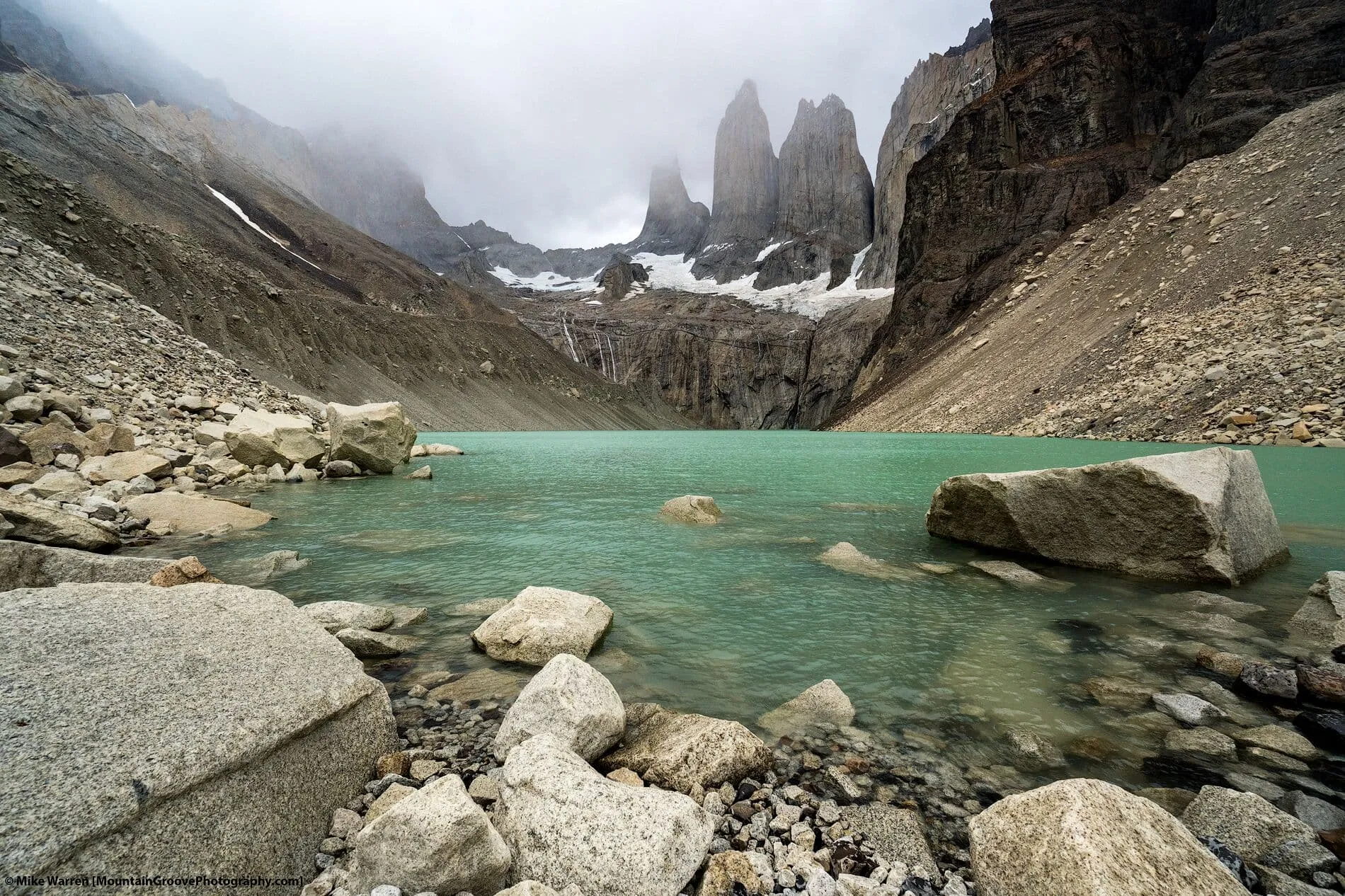If Patagonia is not one your trekking bucket list, you may have missed the pictures of turquoise lakes, snow-powdered peaks, and the most dramatic glaciers. Indeed, when talking about trekking in Patagonia, we are not referring to a famous clothing brand. Patagonia is an area the size of almost 1 million (!) square kilometers shared by Argentina and Chile. It’s massive so where do you start? Your trekking in Patagonia starts right here.
Trekking in Patagonia 2023 Guide – Argentina & Chile

Argentina and Chile share the pie that is Patagonia. There is a healthy competition between the two South American countries about which side of Patagonia is best. Although there literally are dozens of National Parks scattered over Chilean and Argentinean Patagonia, there are two National Parks that grab all the attention from trekking enthusiasts. Torres del Paine National Park on the Chilean side and Los Glaciares National Park on the Argentinean side.
As beautiful as the pictures you see look, Patagonia is a treacherous place that should be treated by respect. Names like the O-Circuit or the W-Trek may sound like you are about to take a walk through the park, but the weather conditions in Patagonia can be hard to gauge and especially treks to El Chaltén and the O-Circuit asks for thorough preparation. Let’s break the options down for you so you can make a well-informed choice when you are heading off for your Patagonia trekking.
Contents
- Trekking in Chilean Patagonia - Torres del Paine
- W-Trek Overview
- O-Circuit Trek Overview
- Torres del Paine Trekking in Winter
- Refugios in Torres del Paine National Park
- How To Get To Torres del Paine
- Trekking in Argentinean Patagonia - Los Glaciares
- El Chaltén Overview
- Best Season for Trekking in Patagonia
- How To Get Fit for Trekking in Patagonia
- Packing List for Trekking in Patagonia
- Where Can I Book My Walking Adventure in Chile?
Trekking in Chilean Patagonia - Torres del Paine
There are dozens of options but many end up at Torres del Paine. It not so hard to understand why. Torres del Paine National Park is home to Las Torres, the Towers. When thinking of Patagonia trekking and trying to find information about it, you are likely to find a photo of the Towers. It makes for a great wallpaper!
There is however more in Torres del Paine. The Grey Glacier, the hanging glacier in the French Valley and the famous Grey Glacier. In Torres del Paine, you are lucky to have all these beautiful highlights within trekking distance. The W-Trek strings all of them together and it is safe to say that this is the most popular trekking option in the entire of Patagonia. The O-Trek, which takes typically twice as long, is also a popular option and includes the Southern Ice Field.

Book Now
W-Trek Overview
The W-Trek is by far the most famous trek in Patagonia. The W stands for the shape of the route if you look at it from a bird’s eye perspective. There are many options if you want to conquer this massif. Although the W-trek is the shortest, it includes the most beautiful highlights of the park.
The W-trek is not that long, which is why many mountaineers choose to do it in 3 days. Nevertheless, we recommend taking it a little bit slower so as to make the most out of every site. With the most varied and colorful landscapes, this trek is guaranteed to leave you speechless. Along the way, you will find hanging glaciers, waterfalls, rivers, lakes, and granite peaks. The red color given by the lengas in autumn and winter provide you with dreamlike sceneries.
5-day W-Trek Itinerary
- Day 1: Transfer to Torres del Paine – Round trip hike to Las Torres lookout point
- Day 2: One way hike to Los Cuernos lookout point
- Day 3: One-way hike to Pehoe Lake, via the French Valley
- Day 4: One-way hike to Glacier Grey – Optional Ice hike or kayak
- Day 5: One-way hike to Catamaran – Transfer back to Puerto Natales
A typical W-Trek itinerary starts and ends at Puerto Natales. Accommodation is typically included when you book a guided or self-guided trek, but this very much depends on availability at the local refugios. Keep reading if you want to know what you can expect at these refugios.
Check out all the W-Trek options here and find your perfect itinerary.

O-Circuit Trek Overview
The O-Trek or the Circuit Trek is a Patagonian classic. The popular hiking trail in Torres del Paine National Park lures the intrepid travelers of this world to South America. It is for those who want to do more than just the W-Trek and know that they have the right physical abilities. As the name suggests, the O-Trek, better known as the O-Circuit, is a circuit. The “O” includes the “W” but things are a bit more interesting because the backside of the mountain gets added in the shape of a long leep.
All in all the O-Trek is worth more than 100 kilometers. You can do the O-Trek in different variations, but most people try to tackle it in about 7 nights and 8 days. There is a limit on the O-Trek, as only 80 people are allowed on the backside of the mountain each day. Will you be one of them? Think turquoise blue lakes, the famous towers of the Torres del Paine, stunning vistas, and a little bit more.
7-day O-Trek Itinerary
- Day 1: Pehoé Boat Terminal to Italiano (Hike Mirador Britanico)
- Day 2: Italiano to Camp Las Torres
- Day 3: Stay at Camp Las Torres (Hike Mirador Las Torres)
- Day 4: Camp Las Torres to Serón
- Day 5: Serón to Dickson
- Day 6: Dickson to Paso
- Day 7: Paso to Pehoé Boat Terminal
A typical O-Trek includes accommodation on campsites. Wild camping is prohibited and the campsites are well-equipped. Note that the O-Trek is closed from the 1st of April to the 30th of September. Because of the unpredictable weather, it is highly recommended to do a guided O-Trek.

Torres del Paine Trekking in Winter
When you think of Patagonia you think about high mountains, snow, and ice, and it doesn’t matter which season you choose, that is what you will get. However, the Winter Treks in Patagonia are for those who are brave enough to experience the true Patagonia: Patagonia in Winter.
If you decide to trek in Torres del Paine in Winter, you will experience temperatures between -10ºC and 10ºC, but in exchange, you will get the best out of the Torres del Paine National Park: fewer crowds and a breathtaking, snow-covered landscape. You can do the traditional W-trek or, if you are feeling more adventurous, you can choose to do some Multisport trekking, where you can combine trekking, kayaking, horseback riding, and Mountain biking. Trek in Winter, get to know the real Patagonia, meet the locals, and live a true and unique adventure at the end of the World!
Refugios in Torres del Paine National Park
If you are doing the W-Trek or the O-Trek in Torres del Paine you are likely to stay in one of the refugios, one of the cabins next to the refugiosor even in a tent on the ground of one of the refugios. When going trekking on this side of Patagonia there is no real way to avoid the refugios. They are massive playing factor when it comes to availability. They are managed by the company Fantastico Sur, a company not always to get a hold of and get your booking through. Trekking companies have good lines with Fantastico Sur and book the accommodation on your behalf.
How To Get To Torres del Paine
You can get to Punta Arenas (IATA code PUQ), the nearest commercial airport to the gates of Torres del Paine, from Santiago de Chile. There are several daily flights that take 3.5 to 4 hours. The most frequent flights are offered by LATAM and Sky Airline.
If you come from Argentina, you will not be able to catch a direct flight to Punta Arenas. From Buenos Aires, it is best to fly to El Calafate and from here move on via bus to Puerto Natales. However, if you by any chance have to possibility to find your way to Torres del Paine via the Chilean way, then this is recommended. The border crossing between Argentina and Chile can suck up a lot of time and money.
The best way to get to Torres del Paine is by bus. In recent years bus transportation has come a long way and buses are comfortable. The views underway are a great warming-up for what you are about to see once you have arrived for your trekking. Coming from Punta Arenas you can easily take a bus to Puerto Natales. Easy, because this is the route most people take on their way to Torres del Paine. You can take either Bus-Sur or Buses Fernandez. Expect to pay an amount of 7.000 to 8.000 pesos (12 USD) for a one-way ticket.

Trekking in Argentinean Patagonia - Los Glaciares
Los Glaciares. It is as majestic as the Spanish name sounds. You’ve guessed it, Los Glaciares means The Glaciers and there are plenty of glaciers to be found in this National Park. In fact, Los Glacieres counts 356 glaciers. You could almost see a glacier a day for an entire year. Obviously, it doesn’t work like that, you can’t just get off the trails and you really don’t have to. From conquering the summit of Mount Fitz Roy to walking over the Perito Moreno Glacier, this park is what every trekker ever dreamed of.
Los Glaciares National Park was declared a World Heritage Site by the UNESCO in 1981 because of its natural beauty, its breathtaking landscapes, and its unique flora en Fauna. While trekking in the park you can get deep in Lenga Forests, camp under the starry night, and walk over, you’ve guessed it again, glaciers.
Los Glaciares National Park is mostly about El Chaltén, Fitz Roy and the Southern Patagonian Icefield. The last one can be accessed via the O-Trek in Torres del Paine as well, but it is just so much easier in Los Glaciares. Of course, there is also Perito Moreno Glacier, but as this can be done in just a day trip, we leave it out the perspective. Let’s give you the break down for some proper Patagonia trekking in Los Glaciares:

El Chaltén Overview
El Chaltén is where it’s at when it boils down to trekking in Argentinean Patagonia. This little town is all about hiking and trekking and soon after arrival you will notice that everyone is there to go hiking and trekking. You would blend right in! There are plenty of day hikes that you can do if you have extra time. You can easily hike to Los Condores and Laguna Capri. These hikes don’t take more than 2 or 3 hours.
The highlights of El Chaltén are best done in 6 days. Only then will you have the chance to truly soak up the magic of this beautiful part of Patagonia. You can make a combination of enjoying great views of Fitz Roy, Cerro Torre and the Southern Ice Field from Paso del Viento. A typical El Chaltén trek starts and ends with a transfer to and from the town of El Chaltén.
6-day El Chaltén Trek Itinerary
- Day 1: El Chaltén - Hosteria el Pilar
- Day 2: Mother & Daughter Lakes - Cerro Torre
- Day 3: Fitz Roy River Crossing - Agachonas Pass
- Day 4: River Tunel Crossing - Viento Pass - Southern Ice Field
- Day 5: Viedma Glacier - Huemul Pass
- Day 6: Viedma Glacier - Bahía Túnel - El Chaltén
During the trek, you will spend your nights in camping sites with different levels of comfort. Your trekking company will provide all the camping equipment necessary, including sleeping bags and mats. The campsites don’t have electricity or showers. Some of the camps have latrine-style long drop toilets with a basic toilet seat.
How To Get To El Chaltén
In comparison to Torres del Paine National Park, it is much easier to get to El Chaltén and Los Glaciares. The most popular choice to get to El Chaltén, and the whole region in general, is to fly to El Calafate. From El Calafate, you have plenty of private shuttles and public buses that can take you to El chaltén.
Best Season for Trekking in Patagonia
You want nice weather when trekking in Patagonia. At the park is situated in the Southern Hemisphere, one has to be mindful of the seasons there. When it is winter in the Northern Hemisphere, it is actually summer in the deep South. Hence, the best trekking season for Torres del Paine and Los Glaciares is during the summer months: From November to early March. However, Spring (September-November) is and Autumn (March-May) is also favorable trekking and hiking seasons, as the crowds are fewer and the natural scenery is colorful.
Think fresh colors in Spring and stunning brown colors in the Fall months. Winter lasts from June to August and it is then that the whole of Patagonia is quiet. At this time of the year, most attractions are closed for maintenance. Regardless of your choice in the trekking season, make sure you bring enough layers for during your hike.

How To Get Fit for Trekking in Patagonia
One sure way to get good at what you do is to practice. The best practice for hiking is hiking. Seeing that you are interested in trekking Patagonia, we assume that you already like hiking to some extent. Hike a bit more. If you are lucky enough to be surrounded by hills or even mountains, it is time to see them more often. When? If you are new to this, we suggest starting six months before your planned departure by simply going for an hour (or two) hike a week. When you get the hang of it, after about three weeks, it’s time to beef up your intensity. Bring a pack of 10 to 15kg and add a longer hike of three hours to your week. If this lifestyle is new to you, you will soon reap the benefits of trekking.
After a good few months of solid hiking, it is time to put your endurance to the test. Do back-to-back long hikes. You can simulate a few days of constant trekking by going hiking for a few days. Easy at that. Plan a smaller trekking holiday or keep it simple by hiking your favorite route on repeat. If you are comfortable hiking for 4 hours a day, 3 days in a row while carrying a 10kg to 15kg backpack, you will be fine.
Packing List for Trekking in Patagonia
If you’re going trekking in Patagonia you must be aware of the fact that the weather conditions are not always like in the pictures. And even the temperatures on the pictures is usually a lot lower than it may seem. The following trekking packing list gives you a good guideline to pack the right gear for the job. Note that there are some items you won’t need to bring when you are making use of accommodation arranged by your trekking company.
Trekking Gear:
- 50 to 60 liters backpack
- Sleeping bag for -12º C comfort min. (synthetic or duvet filling)
- Therma-Rest mat (inflatable better)
- Medium mountain boots with Gore-Tex ideally
- Crocs (for resting at the camps and river wading)
- Trekking poles
- Sun-glasses for snow and ice and googles
- Headlamp with new batteries and spare batteries
- 1-litre bottle (Nalgene ideally)
- Sunblock (35+ or more)
- Lips sunblock
- Minimum personal hygiene items
- Dry bags to protect your staff
- Vacuum bottle 0.5L
- Cup, plate, spoon
Trekking Clothing:
- Gore-Tex waterproof jacket with hood
- Softshell jacket with hood (2nd layer)
- Waterproof light over pants
- Softshell trekking trousers
- Underwear synthetic fabric t-shirt and trousers (2)
- Spare underwear
- Three pairs of trekking socks
- Wind-stopper gloves
- Liner gloves
- Waterproof over gloves
- Warm hut and cap
- Neckerchief or Buff for neck protection (optional)
- Light feather or synthetic warm jacket for the night
Where Can I Book My Walking Adventure in Chile?
At Bookatrekking.com you can book many treks in Chile. We take care of all the details for you, give you personal trekking advice and give you the best service possible. Find all our offers for Chile here. Our easy-to-use platform allows you to browse and compare different trekking options and find the perfect fit for your interests, abilities, and budget.
If you have any questions about a specific trek or need help choosing the right one for you, our team of Trekking Experts is here to assist you. Simply reach out to us and we will be happy to provide you with personalized recommendations and advice to help you plan the trekking adventure of a lifetime.
Is a walking trip in Chile not your cup of tea and are you looking for other epic adventures? Check out one of our following blog posts:
-
Scotland
-
Ireland
About Us






Comments